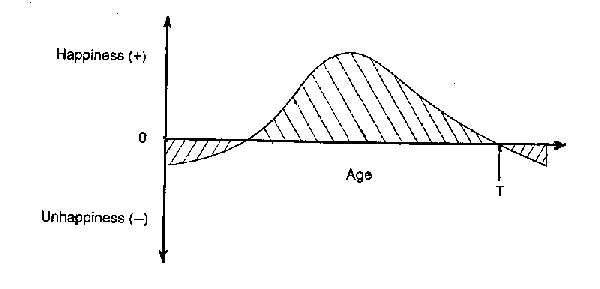
A Theoretical Discussion of the Optimum Time for Life to End
Merwin Sibulkin
Merwin_Sibulkin@brown.eduWhen to Die
We ask the question, "In a liberal society which supports the concept of personal autonomy, when would a rational person choose to die?" The question assumes that there are situations in which rational persons would choose to die in preference to waiting for death to occur from natural causes. Anyone aware of the current controversies over physician assisted suicide cannot doubt that this is the case. The legislation recently put into practice in the state of Oregon (United States) requires, among other things, that a person requesting physician assistance in dying be terminally ill. The law defines a terminal illness as one where death would occur within six months. Terminal illness, however, is not the only reason a rational person would choose to die. Max Charlesworth in Bioethics in a Liberal Society poses the question in the form, "Can we choose, in the name of autonomy, to die when we judge that our continued survival is humanly pointless or that the quality of our future life is likely to be zero?" In what follows we suggest that these formulations may be too restrictive and propose an answer to our original question.
Our proposal is based upon the concept of happiness. This is a much argued subject in philosophy, but we feel that J.S. Mills assertion in Utilitarianism is still persuasive, "Happiness is desirable, and the only thing desirable, as an end; all other things being only described as means to that end". Since about 1960 there has been increasing interest by sociologists in measuring levels of happiness in various populations by administering questionnaires. (A goal of many of these investigations was to find correlations between levels of happiness and factors such as health, education and income; but those results are not of concern here.) Of primary interest to us is the conclusion of Ruut Veenhoven in Conditions of Happiness, a meta-study of 245 such empirical investigations, that people find a question such as, "How happy are you?" to be meaningful and will give quantitative answers.1 Furthermore, three references are given to longitudinal studies in which changes in individuals levels of happiness over time have been measured.

Figure 1. Level of Happiness/Unhappiness as a function of age.
These results suggest that each person can construct their own graph of happiness/unhappiness level as a function of time. The example shown in Figure 1 would result from a life starting with a mildly unhappy childhood followed by years of considerable happiness but then declining into unhappiness with increasing age. The existence of a neutral state between happiness and unhappiness at the horizontal axis in the figure will be essential in what follows. We propose that rational persons would desire the maximum amount of happiness in their lives. In terms of Figure 1 they would desire that the sum of the positive area minus the two negative areas be a maximum, or using a concept from elementary calculus that the integral of happiness over time be a maximum.2 Consider the age labeled T in Figure 1 where the level of happiness goes from a positive to a negative value. If for ages greater than T a person's level of happiness remains negative, then his/her integral of happiness will have reached a maximum at age T and then continually decrease with time. Thus for a rational person who has adequate reasons to conclude that his/her future level of happiness will always be negative, the optimum time to die would be at age T.
The most widely accepted reason for concluding that ones future will be increasingly unhappy is having a terminal illness. For such cases portions of society have agreed that suicide, and physician assistance in suicide, is a reasonable choice. There are, however, additional conditions for which a projection of future unhappiness would be reasonable. These include severe, permanent physical impairment or approaching mental incompetence. After evaluating the effects of such conditions on ones own future quality of life and that of ones loved ones, a rational individual believing in personal autonomy could conclude that age T has been passed and choose to die.
Notes
1. Veenhoven suggests that happiness has two components which she calls (a) hedonic level of affect, and (b) contentment. The (a) component is related to the "pleasantness" of recent experiences and is not consciously controlled; the (b) component is related to the satisfaction of long term goals - thus looking forward and backward - and subject to some voluntary control. The author believes that ones perceived level of happiness involves both components, but not in a quantifiable way.
2. Other life goals are possible. Individuals may desire to experience the most intense level of happiness without regard for its duration.
References
Charlesworth, Max Bioethics in a Liberal Society, Cambridge University Press, 1993
Mill, John Stuart Utilitarianism London, 1863
Veenhoven, Ruut Conditions of Happiness, D. Reidel, 1984
Date submitted July 2000; revised February 2005
Return toIndexpage.